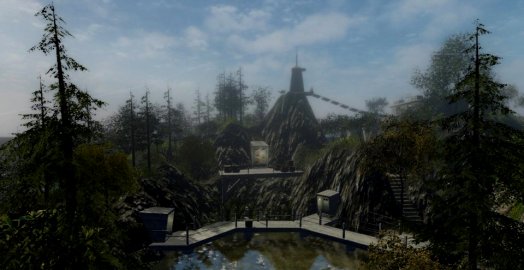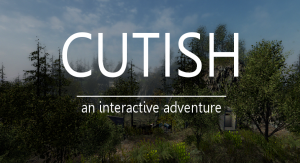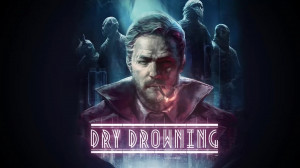Review for Cutish

Whether you are a lover of Myst or you think it was the worst thing to ever happen to the genre, there is no doubt it had a huge impact on the way adventure games were developed and played back in 1993, spawning many clones in the ensuing years (some good, most not so much). If you are a fan of similar first-person puzzlers, you will almost certainly enjoy playing indie developer stigmamax’s Cutish, which does an excellent job of capturing the spirit of Cyan’s classic and its ilk. While it lacks the polish of its more acclaimed predecessors, it more than makes up for it in the puzzle and exploration departments, which will keep you playing to discover all its hidden mysteries.
Like most games of this style, you play as a nameless, faceless, genderless hero stranded on a strange deserted island, this time after your plane crashed just offshore. With no idea of who you are or what caused the accident, there is only one thing to do: start exploring. Unfortunately, here is where you immediately run into issues with the game mechanics. First, the movement controls are counterintuitive to free-roaming 3D adventures. Instead of the standard WASD layout, you must use the QDZS keys. And because there is no option to change the key bindings, you will have to get used to this, which takes a bit of practice.
What’s worse is that there is no indication of what items in the environment you can interact with – no hotspot indicator, no active cursor, nothing – so you need to click on pretty much everything you see to find out if you can collect, move, or manipulate an object, or if doing so will cause some sort of action. I had a really hard time adjusting to this type of interface and missed many critical items and actions early on. Once I adjusted, I was able to complete the game with only occasional walkthrough consultation, but it still made the game much more difficult to play than it needed to be. When you do correctly click on something interactive, in most instances you will see a comment at the bottom of the screen with a brief description that adds flavour, like the name of the artist that painted a picture on the wall. If the item is related to a puzzle, the game will provide some help as to what is needed, such as saying you need a key if you click on a locked desk drawer.
Another curious design choice is the inventory system. If you happen to click on something that can be collected, it is done automatically, with a brief view of your stash. But once acquired there is no ability to click on items to get information about them or manipulate/combine them. In most cases it is obvious what the object is (crowbar, matches, fuel can, etc.) but in some instances I had no idea – what I thought was a flare turned out to be a metal pin. This isn’t too much of a problem, however, as each item is used automatically when you click on the correct place.
Once past the initial learning curve, you are free to enjoy Cutish's impressive presentation. The graphics are very well done, with clear, crisp 3D environments and appropriate animations of trees and grass swaying, water rippling, lava flowing, and more, as well as wildlife such as various birds flying around and landing nearby. There are also changing time and weather effects that alternate between a clear, sunny day and a thunderstorm at night. While the thunderstorms are rare, the darkness does prevent you from being able to see some important clues while they last. When this happens, you just need to wait for conditions to change again and return to those areas.
Though there isn’t a great deal of environmental storytelling done here, I enjoyed the many subtle items you can look at, such as the pinup girl wall calendars from the 1950s, black and white photographs, paintings, and so on. There is even a fun Easter egg homage to Myst and its first two sequels, complete with the theme music playing quietly in the background when you examine them.
Sound effects are a bit of a mixed bag: very good for the most part, but jarring in some places such as the loud and clunky walking sounds on the wooden planks and main path of the island. Ambient atmosphere is excellent, including birds chirping, the ocean surf breaking on the shore, and energy beams crackling, among others. These really add to the immersion and make exploring quite enjoyable. Music is orchestral in nature and loops in the background of most locales, but it is not repetitive to the point of being annoying. In many parts of the game, the accompaniment suits the setting, such as religious-sounding music with a choir singing in the background when reading bible verses from a journal.
Where the game really shines, as it does in any good Myst-style adventure, is in its exploration and puzzles. What first appears to be a fairly small island turns out to have a lot of nooks and crannies to visit once you crack the various codes needed to unlock them. Cutish provides lots of opportunities for discovery. Early on you come across a hut built by a survivor that was stranded here before you. Inside is a journal (note: you can turn the pages by dragging and dropping the mouse cursor to read it – not obvious!) that reveals all kinds of interesting things. Most importantly, you learn that this person has created a system that can help decode important clues you find scattered around. You will need to return to the hut each time you find a code, which requires a fair bit of backtracking.
Once the island begins opening up, there is a surprising amount of real estate to explore, most of it in underground bunkers and caves, but also on the surface extending out to the pier jutting into the ocean, and up to the tops of some of the structures, from which there are some breathtaking views of this volcanic island. Of particular note is the lava flowing from the center of the island to the sea, where you can see the steam rising as the magma meets the water.
The subterranean locations vary in size, with some fairly small and others quite large with several rooms to check out. Some rooms are just for atmosphere, but most have clues hidden in them that provide a necessary code of one kind or another. In one area you even get to go swimming, while in another you must activate and then ride an elevator to reach your destination. There is enough variety in these locales to hold your interest right to the final area and its tough timed puzzle.
Progress is very linear, but figuring out the next clue to access a new area is both challenging and rewarding, as many of the puzzles are real head-scratchers. The first one you encounter – a fairly simply turning of notched stones to unlock a door – might deceive you into thinking things will be easy, but the difficulty ramps up quickly. You will have to examine every object you encounter very carefully to glean information that will be needed later. Among the obstacles you face are magnetically locked gates that subsequently provide access to several doors that require four-digit codes to open. These are two-part puzzles: first discover and then decode the sequence of numbers and letters needed to open each gate, then determine the four-digit codes needed to open one or more doors behind it.
After solving the early notched stone puzzle, you get the code to a key location: the Camera Room. Here is where you’ll enter the codes to the magnetic locks on a terminal to open them. You will need to return here many times to complete the game. While figuring out the initial gate codes is fairly straightforward, working through the four-digit codes can be a real challenge, and the puzzles you need to solve are quit inventive. For example, one clue requires you to figure out how many of each type of object (depicted as a drawing) are on the island and do some math to obtain the correct answer. This requires careful observation (and notetaking) to solve. Another puzzle has you figuring out the age of people that have been buried and applying math from a totally different clue found elsewhere. Each code has similarly varied layers and is a delight to solve.
Other obstacles simply take time to overcome. As you explore the island you will acquire several “chips,” which are scraps of paper that are added to your inventory. As you get closer to the end of the game, these scraps form words and numbers that are clues to solve two more puzzles in different areas. You will also collect letters needed to solve a puzzle box to get a key item.
In terms of story, Cutish is paper thin. It is evident early on from reading the journal that the island is home to some sort of high security installation. There is a tailings pond with a pipe spewing toxic waste of some sort, and many rooms contain radioactive material, so it looks like some sensitive research was being conducted here, but it is not clear exactly what kind. Later you’ll discover another journal, this one documenting the people that built and/or occupied the installation in the early 1970s. These log entries answer the question of why the island was chosen and the structures built, as well as explain the nature of the towers dotted around the island, though there are no real ground-breaking surprises to be uncovered.
As an independent game by a small studio, Cutish has certain elements that lag behind its more polished, bigger-budgeted inspirations. Many of the bugs that existed in the initial launch version of the game have already been addressed in updates, but some technical problems and questionable design issues remain. One bit of user-unfriendliness is the lack of either manual saves or checkpoint features. To record your progress, you must open up the game menu and quit. There’s no in-game reason why you should need to save before then, but at one point a glitch prevented me from exiting the game properly and therefore saving in the process.
It is possible to intentionally quit the game without recording your progress, which is handy as you can get physically stuck in some areas, but even this comes with complications. For example, I thought it would be clever to bypass a locked door by jumping a fence, but then realized I could not go back the way I came and so needed to bail. However, the game uses the F12 key to do this, and in the Steam version this results in taking a screenshot instead of exiting. So you need to go to the main menu, select the “Info” option and use the F12 key from there to get out.
Also, be aware: if you accidentally choose the “Start New Game” option from the main menu, you are not warned that your progress will be lost – a major flaw for any game! Finally, it should be noted that there are many locked doors on the island that require four-digit codes to unlock. However, once you have discovered the code and unlocked the door, it does not remain unlocked – you need to re-enter the same code each time you want to access that area. Since there are some locations you will need to revisit many times, this gets very repetitive.
Given the surprisingly expansive environment filled with challenging puzzles, you can expect a solid 6-8 hours of gameplay from Cutish. And I enjoyed every minute, despite my initial frustrations with how the game handled. There are many well-designed, original and varied puzzles, some of which will really test you and may even require outside help to solve. The backstory is relatively weak, but it provides sufficient framework to make sense of why you are doing the things you are. If you are a fan of this type of game, or puzzle-rich games in general, you aren’t likely to be disappointed by this indie Myst-style adventure, even with its rough edges. The developer has hinted that he is already thinking of another similar game with a larger environment and even more puzzles. I can hardly wait.






























